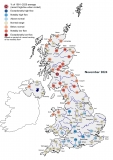Submitted by Steve Turner on
March was a characteristically transitional spring month: an unsettled first half with wet and occasionally wintry conditions gave way to a largely fine and dry second half. Average temperatures for the month were typical and rainfall totals were near-average or below (markedly so in eastern Britain). While March was relatively quiescent, meteorologically, it was notable for the continuing hydrological response to the exceptionally wet February. River flows were substantially above average across large parts of the country, with notable peak flows in some catchments early in the month. Correspondingly, the widespread floodplain inundations seen in late February continued into early March, with more modest property damage than prior months but significant disruption and locally severe impacts. The risk of further flooding diminished as more settled anticyclonic conditions prevailed in the second half of March, resulting in rapid drying of soils and steep recessions in responsive rivers. While groundwater recessions commenced at over half the index boreholes by month-end, levels increased in some boreholes and notable or exceptionally high March levels were widespread (with groundwater flood warnings, e.g. in Dorset into the final week). Given above-average March groundwater levels and flows, and near-average reservoir stocks at the national scale, the water resources situation is healthy. However, the continued intensification of soil moisture deficits (SMDs) and river flow recessions into early April, coupled with current outlooks which favour drier spring conditions, suggests vigilance will be needed in more responsive catchments, as evapotranspiration rates climb through the spring.



